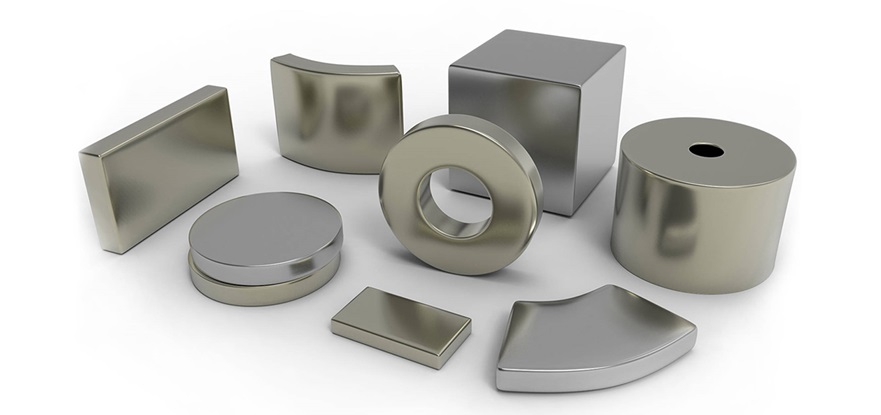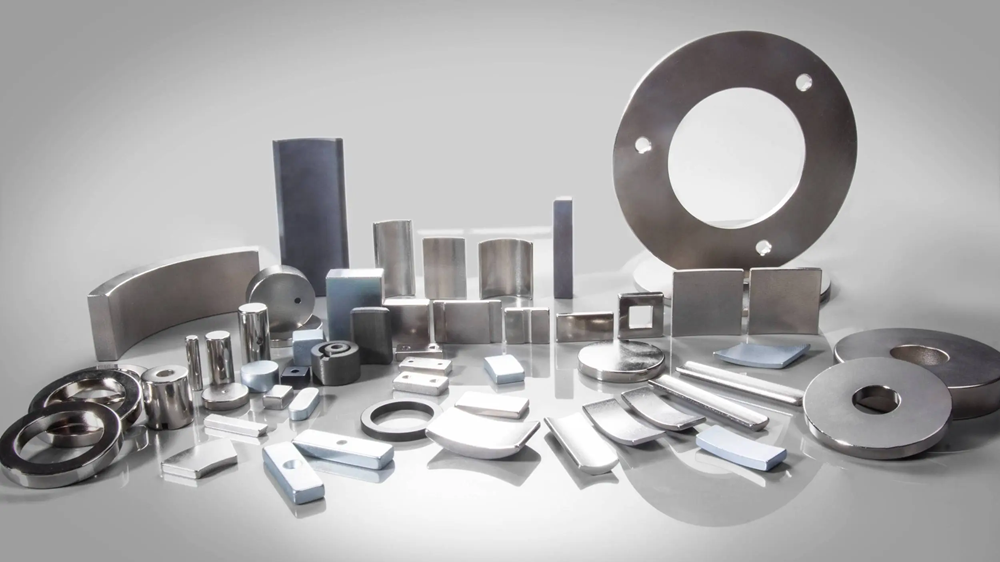
What is a sintered NdFeB magnet? It is a remarkable innovation in the field of permanent magnets, crafted from an alloy of neodymium, iron, and boron. This magnet is renowned for its exceptional magnetic strength, with an energy product that positions it as the most powerful commercialized permanent magnet available today. Its high coercivity and remanence make it ideal for a wide range of applications, including electric motors and consumer electronics. The sintering process significantly enhances its performance, ensuring it meets the rigorous demands of high-performance industries. Understanding what a sintered NdFeB magnet is highlights its pivotal role in advancing modern technology.
Key Takeaways
- Sintered NdFeB magnets are made from an alloy of neodymium, iron, and boron, making them the most powerful commercialized permanent magnets available.
- The sintering process enhances the magnet’s performance by creating a fine-grain structure, which improves magnetic alignment and stability at high temperatures.
- These magnets are ideal for various applications, including electric motors, consumer electronics, and automotive components, due to their exceptional magnetic strength and thermal stability.
- While sintered NdFeB magnets offer superior performance, they can be brittle and require careful handling to prevent damage during manufacturing and application.
- The production of sintered NdFeB magnets involves complex processes, which can lead to higher costs, but their performance often justifies the investment in demanding industries.
- Understanding the properties and applications of sintered NdFeB magnets can help industries leverage their strengths for improved efficiency and innovation.
Understanding Sintered NdFeB Magnets
Definition and Composition
When I first encountered the term “sintered NdFeB magnet,” I was curious about its composition and what made it stand out. A sintered NdFeB magnet is a permanent magnet crafted from an alloy of neodymium, iron, and boron. This combination forms a tetragonal crystal structure, which is key to its powerful magnetic properties. The sintering process involves heating the powdered materials to create a solid block, enhancing the magnet’s performance. This method results in a fine-grain structure, improving magnetic alignment and allowing the magnet to maintain its properties even at high temperatures.
Key Properties
Magnetic Strength
The magnetic strength of sintered NdFeB magnets is truly remarkable. These magnets boast the highest magnetic properties among commercialized permanent magnets, with energy products ranging from 33 MGOe to 51 MGOe. This strength makes them ideal for applications requiring powerful magnetic fields, such as electric motors and generators. I find it fascinating how these magnets can deliver such high performance, making them indispensable in various industries.
Temperature Resistance
Temperature resistance is another critical property of sintered NdFeB magnets. They maintain their magnetic and mechanical performance even under high temperatures. This stability is crucial for applications in demanding environments, such as wind turbines and automotive components. The ability to withstand temperature variations without losing strength ensures that these magnets remain reliable and efficient in their roles.
Manufacturing Process of Sintered NdFeB Magnets
Compaction
In the manufacturing process of sintered NdFeB magnets, compaction serves as a crucial initial step. I find it fascinating how this process begins with the smelting of the alloy, which is then finely powdered. The powdered material undergoes pressing in a magnetic field to form a compact. This step ensures that the particles align properly, enhancing the magnet’s eventual performance. The precision required in this stage lays the groundwork for the magnet’s high magnetic energy and strength.
Sintering
Sintering follows compaction and plays a pivotal role in the production of these powerful magnets. During this phase, the compacted material is heated in an inert gas or vacuum environment. This heating process causes the particles to bond, resulting in densification. I appreciate how this step transforms the compact into a solid block, which is essential for achieving the desired magnetic properties. The sintering process is meticulous, ensuring that the magnet retains its structural integrity and magnetic strength.
Grinding and Coating
The final stages of manufacturing involve grinding and coating. After sintering, the magnet blank requires mechanical processing to achieve the desired shape and size. Techniques such as wire cutting, slicing, and grinding are employed to refine the magnet. I find it intriguing how these processes allow for customization, enabling the production of magnets suitable for various applications. Coating follows grinding, providing a protective layer that enhances the magnet’s resistance to corrosion. This step ensures the longevity and durability of the sintered NdFeB magnets, making them reliable for use in electronics, medical equipment, and other demanding fields.

Applications of Sintered NdFeB Magnets
Industrial Uses
In the industrial sector, I have observed that sintered NdFeB magnets play a crucial role. Their exceptional magnetic strength makes them indispensable in heavy machinery components and motors. These magnets are often used in magnetic separators, which are essential for removing metal contaminants from various materials. I find it fascinating how they enhance the efficiency of industrial processes by ensuring the purity of products. Additionally, their application in generators and electric vehicles highlights their importance in sustainable energy solutions. The ability of these magnets to withstand harsh conditions without losing performance makes them a preferred choice in demanding industrial environments.
Consumer Electronics
Sintered NdFeB magnets have revolutionized consumer electronics. I have seen their impact firsthand in devices like speakers and computer disk drives. Their high magnetic strength allows for compact designs without compromising performance. In speakers, these magnets produce clear and powerful sound, enhancing the audio experience. In computer disk drives, they enable rapid data access and storage, which is vital for modern computing needs. The reliability and efficiency of sintered NdFeB magnets make them a cornerstone in the development of advanced electronic devices. Their role in consumer electronics underscores their versatility and adaptability to evolving technological demands.
Automotive Industry
The automotive industry benefits significantly from sintered NdFeB magnets. I have noticed their widespread use in electric vehicles, where they contribute to the efficiency of electric motors. These magnets provide the necessary torque and power, ensuring smooth and efficient vehicle operation. Their application extends to sensors and switches, which are critical for vehicle safety and performance. The high-temperature stability of sintered NdFeB magnets ensures they function reliably under the hood, where temperatures can soar. Their contribution to the automotive industry not only enhances vehicle performance but also supports the shift towards greener transportation solutions.
Advantages and Disadvantages
Advantages
Superior Magnetic Performance
I have always been impressed by the superior magnetic performance of sintered NdFeB magnets. These magnets exhibit remarkable intrinsic coercive force and excellent demagnetization curve rectangularity. Their high energy products, ranging from 33 MGOe to 51 MGOe, make them the most powerful commercialized permanent magnets available. This strength allows them to perform exceptionally well in applications requiring compact size and high performance, such as electric motors and wind turbines. The ability to maintain high magnetic properties even under demanding conditions underscores their value in modern technology.
High-Temperature Stability
High-temperature stability is another significant advantage of sintered NdFeB magnets. I find it fascinating how these magnets can operate efficiently at elevated temperatures without losing their magnetic properties. This thermal stability is crucial for applications in harsh environments, such as automotive components and industrial machinery. The magnets’ ability to withstand temperature variations ensures consistent performance, making them reliable in various high-performance applications. Their excellent thermal stability has contributed to their widespread use and continued development in global markets.
Disadvantages
Brittleness
Despite their many advantages, sintered NdFeB magnets have some drawbacks. One notable disadvantage is their brittleness. I have observed that these magnets can be prone to chipping and cracking under mechanical stress. This brittleness requires careful handling during manufacturing and application to prevent damage. While their magnetic properties are impressive, the physical fragility of these magnets can limit their use in certain situations where mechanical durability is essential.
Cost
Cost is another factor to consider when evaluating sintered NdFeB magnets. Although they offer high performance, the production process involves complex steps and expensive raw materials, leading to higher costs compared to other types of magnets. I have noticed that market demands focus on reducing sales prices while maintaining high energy products and thermal stability. Despite their cost, the exceptional performance and application value of sintered NdFeB magnets often justify the investment, especially in industries where superior magnetic properties are critical.
Sintered NdFeB magnets have become indispensable in modern technology. Their exceptional magnetic properties make them suitable for a wide range of applications, from electric vehicles to consumer electronics. I have seen firsthand how these magnets contribute to efficient power generation and conversion, especially in the automotive industry. Despite their brittleness and cost, their high performance justifies their use in demanding environments. The unique value and charm of sintered NdFeB magnets lie in their ability to meet the rigorous demands of high-performance industries, showcasing their pivotal role in advancing technology.
FAQ
What are sintered NdFeB magnets?
Sintered NdFeB magnets are powerful permanent magnets made from an alloy of neodymium, iron, and boron. The sintering process enhances their magnetic properties, making them the most powerful commercialized permanent magnets available today.
How are sintered NdFeB magnets manufactured?
The manufacturing process involves several steps. Initially, the alloy is smelted and finely powdered. This powder is then compacted in a magnetic field to align the particles. The compacted material undergoes sintering, where it is heated to form a solid block. Finally, grinding and coating refine the magnet’s shape and provide corrosion resistance.
What applications use sintered NdFeB magnets?
These magnets find applications in various fields due to their high magnetic strength and thermal stability. They are commonly used in electric motors, wind turbines, hard disk drives, and magnetic fasteners. Their ability to maintain performance under high temperatures makes them ideal for demanding environments.
Why are sintered NdFeB magnets preferred over other types?
Their superior magnetic performance and high-temperature stability make them a preferred choice. The sintering process creates a fine grain structure, improving magnetic alignment and allowing use under high temperatures without losing magnetic or mechanical performance.
Are there any disadvantages to using sintered NdFeB magnets?
Yes, there are some drawbacks. Sintered NdFeB magnets can be brittle, making them prone to chipping and cracking under mechanical stress. Additionally, their production involves complex steps and expensive raw materials, leading to higher costs compared to other magnets.
How do sintered NdFeB magnets perform in high-temperature environments?
These magnets exhibit excellent thermal stability, maintaining their magnetic properties even at elevated temperatures. This makes them suitable for applications in harsh environments, such as automotive components and industrial machinery.
Can sintered NdFeB magnets be customized for specific applications?
Yes, they can be customized. After sintering, the magnet blank undergoes mechanical processing to achieve the desired shape and size. Techniques like wire cutting, slicing, and grinding allow for customization, enabling the production of magnets suitable for various applications.
What makes sintered NdFeB magnets unique?
Their unique combination of high magnetic strength, thermal stability, and fine grain structure sets them apart. These properties enable a wide range of applications, making them indispensable in modern technology.
How do sintered NdFeB magnets contribute to sustainable energy solutions?
Their application in electric motors and wind turbines highlights their importance in sustainable energy solutions. These magnets enhance the efficiency of power generation and conversion, supporting the shift towards greener technologies.
What should be considered when handling sintered NdFeB magnets?
Due to their brittleness, careful handling is essential to prevent damage. Proper storage and transportation methods should be employed to avoid chipping and cracking. Despite their fragility, their exceptional performance justifies their use in demanding applications.
